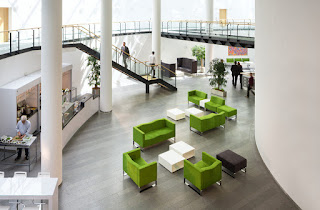Though experts see the architectural trend as a knee-jerk response to the claustrophobic cubicle layout, open offices have been around for a while, thanks to those who sought a more potent way to democratize workspaces. The design is mostly preferred by creative industries, particularly in the field of social media. Apple’s soon-to-be constructed campus in Cupertino, Google’s rendering of modern offices, and Facebook’ s newly launched headquarters in Menlo Park, California, have made it easy to see why the open space trend has caught on as one of the hallmarks of 21st century design and corporate thinking.
Image source: kloeber.com
Apparently, open office trend overrides the sense of detachment and concealment with a culture of transparency where idea-generation and flexibility are the biggest components. Privacy and noise appear to be the major repercussions of open working environments, but experts agree that such difficulties can be with solved with smart comfortable conference spaces and by carefully considering who to put where. Creating mindful environments should involve using smart technologies, sustainable design platforms and other touch points that stimulate cooperation and inspiration for both agoraphobics and claustrophobics.
Image source: squarespace.com
Compared with closed-office plans, the former sees proximity as an effective way to form a symbolic sense of organizational mission where everyone knows their value and their place in the corporate structure. The layout reflects what the company does and who are the team behind it, typifying a dynamic customer space wherein employees can connect to the consumers and to the brand itself. This trait points to the changing landscape of corporate relationships wherein formalities between clients have somehow become relaxed as have corporate hierarchies, insinuating a renewed perception of community in the business environment.
Tom Wolters has served as the senior director of the NYSE-listed ConAgra Foods in which he used his solid business acumen and entrepreneurial skills to help propel the company to global success. See his complete profile here.

